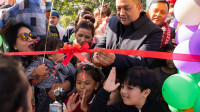Culture & Lifestyle
Cerebral palsy explained
Inclusion Coach Rama Karki breaks down this motor disorder and how inclusive education can help the children diagnosed with it.
Apecksha Gurung
Although cerebral palsy is a common motor disorder that affects 1 in 345 children, many individuals are still unaware of this condition that affects an individual’s ability to move. Here, Inclusion Coach Rama Karki breaks down what cerebral palsy is and how inclusive education can help children with this disorder and adapt to society better. Karki is currently pursuing a PhD in cerebral palsy, so she is on course to becoming the first Nepali woman to earn a doctorate in the subject.
What is cerebral palsy? What causes it?
Cerebral palsy is a child disability that occurs when the mother has an infection during pregnancy or if the child gets infected after birth. In this case, there is a lesion in some parts of the brain, like the cerebellum or cerebrum. Cerebral palsy, according to studies, is not hereditary, but it has not been researched well in Nepal.
If a child gets cerebral palsy, their cerebrum, cerebellum or medulla oblongata gets affected due to lack of oxygen, which affects their motor and sensory organs.
How is cerebral palsy diagnosed? What are its symptoms?
Children with this condition lose voluntary movement in their hands and legs as they grow, resulting in barriers to many bodily functions—including motor and sensory functions. Corresponding to the symptoms, even six months after birth, the child may not be able to stand, which results in them developing weak muscles. If they can’t walk even after some more months, it will permanently disrupt their mobility. All of this is suggestive of cerebral palsy.
How long do children with cerebral palsy live? Where can one get its treatment?
Children with cerebral palsy can live a qualitative life for about 20 years. We cannot just study cerebral palsy through a medical model. We need to work on the treatment and education programme together, which means its treatment needs to apply social and holistic models. Treatment for cerebral palsy is available here in Nepal at the Dhapakhel (Kathmandu) based institute, Selfhelp Group for Cerebral Palsy (SGCP).
Some individuals with cerebral palsy will have to undergo a surgery called Selective Dorsal Rhizotomy (SDR) to cure it. It is the latest neurosurgical procedure—mostly practised in Australia and America.
Neurosurgeon Dr Basant Pant, who considers cerebral palsy as a neurological disability, has started performing this procedure in Nepal too. He has already performed it successfully on four patients at Annapurna Hospital, Maitighar.
SDR is not a dangerous surgery, but it may take upto 5 to 6 hours. I have coordinated with the team at Annapurna Hospital. We have screened 40 children to date, but only four were in need of surgery. Everyone doesn't need it.
Schools need to adopt inclusive education to integrate children with cerebral palsy into the environment effectively.
What are some assumptions related to cerebral palsy?
I’m happy to share that a lot of people are aware of cerebral palsy today, and it is being covered in the media too. However, there are still some stereotypes and false assumptions about it commonly believed by many. People assume cerebral palsy is similar to developmental delay and children’s disabilities which isn’t true.
What is inclusion education?
Inclusion education helps schools to form inclusive alliances with everyone in an effective way. UNICEF defines it as ‘the most effective way’ to provide real learning opportunities for groups who have traditionally been excluded—to not only children with disabilities but speakers of minority languages too.

Does Nepal practice inclusive education?
Our country’s education policy does mention inclusion education. However, many private schools still refuse to enrol children with disabilities. So, the government should take this matter seriously and train more teachers to ensure these children’s conditions are treated with respect.
How has your experience working as an inclusion coach been so far?
I have had some truly wonderful experiences with people from all walks of life through my work. One patient I remember vividly is Amrita Gyawali, the first wheelchair model in Nepal. I can still call back our working with her and now, she is in Japan, happily married and living well.
How do children with cerebral palsy suffer mentally?
A child plagued by cerebral palsy already suffers a lot physically. On top of that, they do not get accepted into schools and get next to zero support from friends. The lack of stringent government policy makes the matter even worse.
We can learn more about how differently-abled individuals’ experiences through Jhamak Kumari Ghimire’s book, ‘Jiwan Kada Ki Phool’.
What role can the government play in supporting individuals with cerebral palsy?
An individual suffering from spinal cord injury gets a monthly allowance of Rs100,000 from the government. However, a person with a disability gets only Rs4,000 every month. So, the first thing our government should do is increase the allowance given to individuals with disabilities.
The government should also work on spreading information about this condition to as many people as possible.




 13.12°C Kathmandu
13.12°C Kathmandu


.jpg&w=200&height=120)












